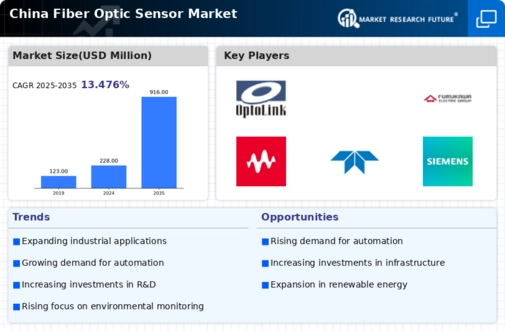Rising Industrial Automation
The increasing trend of industrial automation in China is driving the fiber optic sensor market. As industries seek to enhance efficiency and reduce operational costs, the demand for advanced sensing technologies is on the rise. Fiber optic sensors offer superior performance in harsh environments, making them ideal for applications in manufacturing, oil and gas, and energy sectors. The market is projected to grow at a CAGR of approximately 15% over the next five years, reflecting the growing reliance on automation technologies. This shift towards automation necessitates the integration of reliable sensing solutions, thereby propelling the fiber optic-sensor market forward. Furthermore, the push for smart factories and Industry 4.0 initiatives is likely to further stimulate demand for these sensors, as they provide critical data for process optimization and predictive maintenance.
Growing Focus on Renewable Energy
The shift towards renewable energy sources in China is creating new opportunities for the fiber optic sensor market. As the country aims to reduce its carbon footprint and increase the share of renewables in its energy mix, the need for efficient monitoring and management systems becomes paramount. Fiber optic sensors are increasingly utilized in wind farms, solar power plants, and hydroelectric facilities for monitoring performance and ensuring operational efficiency. The market for these sensors in renewable energy applications is projected to grow by approximately 20% annually, driven by the expansion of renewable energy projects. This trend indicates a strong potential for fiber optic sensors to play a vital role in the sustainable energy landscape.
Advancements in Telecommunications
The telecommunications sector in China is undergoing rapid advancements, which is positively influencing the fiber optic sensor market. With the rollout of 5G technology, there is a heightened demand for fiber optic sensors to support network infrastructure and enhance communication capabilities. These sensors are essential for monitoring network performance, ensuring reliability, and managing data traffic effectively. The fiber optic-sensor market is expected to witness a growth rate of around 18% as telecommunications companies invest in upgrading their infrastructure. This trend highlights the critical role that fiber optic sensors play in the evolving telecommunications landscape, as they provide the necessary data for optimizing network operations.
Increased Research and Development Activities
The fiber optic sensor market is experiencing a surge in research and development activities in China, driven by both academic institutions and private enterprises. This focus on innovation is leading to the development of new sensor technologies that offer enhanced capabilities and applications. As industries seek to adopt cutting-edge solutions, the demand for advanced fiber optic sensors is likely to increase. Investments in R&D are projected to rise by approximately 25% over the next few years, indicating a strong commitment to advancing sensor technology. This trend suggests that the fiber optic-sensor market will continue to evolve, with new applications emerging in various sectors, including healthcare, environmental monitoring, and industrial automation.
Government Initiatives for Infrastructure Development
China's government is heavily investing in infrastructure development, which is significantly impacting the fiber optic sensor market. Initiatives such as the Belt and Road Initiative aim to enhance connectivity and infrastructure across the region. This investment includes the deployment of advanced sensing technologies for monitoring structural health, environmental conditions, and safety in construction projects. The fiber optic-sensor market is expected to benefit from these developments, as these sensors are essential for real-time monitoring and data collection. With an estimated investment of over $1 trillion in infrastructure projects, the demand for fiber optic sensors is likely to see a substantial increase, as they play a crucial role in ensuring the integrity and safety of infrastructure.



















Leave a Comment